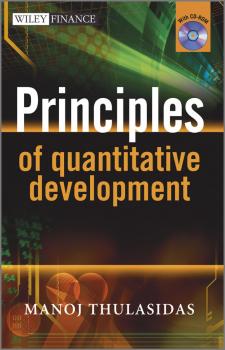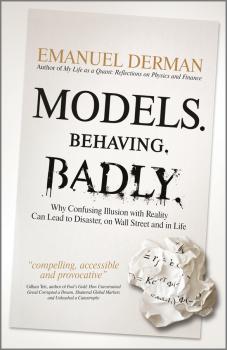Управление, подбор персонала
Различные книги в жанре Управление, подбор персоналаSwaps and Other Derivatives
Richard Flavell has a strong theoretical perspective on swaps with considerable practical experience in the actual trading of these instruments. This rare combination makes this welcome updated second edition a useful reference work for market practitioners. —Satyajit Das, author of Swaps and Financial Derivatives Library and Traders and Guns & Money: Knowns and Unknowns in the Dazzling World of Derivatives Fully revised and updated from the first edition, Swaps and Other Derivatives, Second Edition, provides a practical explanation of the pricing and evaluation of swaps and interest rate derivatives. Based on the author’s extensive experience in derivatives and risk management, working as a financial engineer, consultant and trainer for a wide range of institutions across the world this book discusses in detail how many of the wide range of swaps and other derivatives, such as yield curve, index amortisers, inflation-linked, cross-market, volatility, diff and quanto diffs, are priced and hedged. It also describes the modelling of interest rate curves, and the derivation of implied discount factors from both interest rate swap curves, and cross-currency adjusted curves. There are detailed sections on the risk management of swap and option portfolios using both traditional approaches and also Value-at-Risk. Techniques are provided for the construction of dynamic and robust hedges, using ideas drawn from mathematical programming. This second edition has expanded sections on the credit derivatives market – its mechanics, how credit default swaps may be priced and hedged, and how default probabilities may be derived from a market strip. It also prices complex swaps with embedded options, such as range accruals, Bermudan swaptions and target accrual redemption notes, by constructing detailed numerical models such as interest rate trees and LIBOR-based simulation. There is also increased discussion around the modelling of volatility smiles and surfaces. The book is accompanied by a CD-ROM where all the models are replicated, enabling readers to implement the models in practice with the minimum of effort.
Principles of Quantitative Development
Principles of Quantitative Development is a practical guide to designing, building and deploying a trading platform. It is also a lucid and succinct exposé on the trade life cycle and the business groups involved in managing it, bringing together the big picture of how a trade flows through the systems, and the role of a quantitative professional in the organization. The book begins by looking at the need and demand for in-house trading platforms, addressing the current trends in the industry. It then looks at the trade life cycle and its participants, from beginning to end, and then the functions within the front, middle and back office, giving the reader a full understanding and appreciation of the perspectives and needs of each function. The book then moves on to platform design, addressing all the fundamentals of platform design, system architecture, programming languages and choices. Finally, the book focuses on some of the more technical aspects of platform design and looks at traditional and new languages and approaches used in modern quantitative development. The book is accompanied by a CD-ROM, featuring a fully working option pricing tool with source code and project building instructions, illustrating the design principles discussed, and enabling the reader to develop a mini-trading platform. The book is also accompanied by a website http://pqd.thulasidas.com that contains updates and companion materials.
The Online Trading Cookbook
The Online Trading Cookbook is a unique resource for busy online traders of all levels, addressing the need amongst the growing number of those trading and investing from home for solid, low risk trading strategies which they can incorporate into a busy lifestyle. Suitable for all levels of retail trader and is supplemented by useful advice on the best trading tools, websites and brokers, the different markets available to trade, tips on risk and money management. The book is divided into sections based on levels of complexity and contains specific strategies used by profitable hedge funds as well as strategies used by other professionals, all of which can be implemented by private investors. The opening chapter discusses the professional tools traders will need, from multi-screen hardware, best websites, trading software, data services, brokers, trading products and the types of traders suited to each type of trading. The following chapters give concise novice, intermediate and advanced strategies for short and long term traders. The cookbook format is one of the most popular for teaching complicated subjects. Trading skills are presented and learnt as simply as recipes. This book provides exactly that from trading strategies to risk and money management. Each page presents as ingredients what the trader needs to do, the tools and the preparation with successful examples illustrated on the facing page. Both the proven format and its simplicity are compelling and unique in their application to trading. Written by two celebrated experts in the field, The Online Trading Cookbook is the perfect starting point for anyone wishing to learn to trade or for advanced traders wishing to further their knowledge.
FX Options and Smile Risk
The FX options market represents one of the most liquid and strongly competitive markets in the world, and features many technical subtleties that can seriously harm the uninformed and unaware trader. This book is a unique guide to running an FX options book from the market maker perspective. Striking a balance between mathematical rigour and market practice and written by experienced practitioner Antonio Castagna, the book shows readers how to correctly build an entire volatility surface from the market prices of the main structures. Starting with the basic conventions related to the main FX deals and the basic traded structures of FX options, the book gradually introduces the main tools to cope with the FX volatility risk. It then goes on to review the main concepts of option pricing theory and their application within a Black-Scholes economy and a stochastic volatility environment. The book also introduces models that can be implemented to price and manage FX options before examining the effects of volatility on the profits and losses arising from the hedging activity. Coverage includes: how the Black-Scholes model is used in professional trading activity the most suitable stochastic volatility models sources of profit and loss from the Delta and volatility hedging activity fundamental concepts of smile hedging major market approaches and variations of the Vanna-Volga method volatility-related Greeks in the Black-Scholes model pricing of plain vanilla options, digital options, barrier options and the less well known exotic options tools for monitoring the main risks of an FX options’ book The book is accompanied by a CD Rom featuring models in VBA, demonstrating many of the approaches described in the book.
The Blackwell Companion to Maritime Economics
The Blackwell Companion to Maritime Economics presents comprehensive and in-depth coverage of the entire scope of issues relating to shipping and port economics. Unprecedented survey of maritime economics provides full coverage of shipping and port economics In depth examinations offer an up-to-date study of the field including all facets of shipping, ports, logistics, and maintenance and topical discussion on security and environmental problems Presents original theories relating to theories for maritime carriers and ports Features contributions from the most respected international specialists in the field
Models. Behaving. Badly. Why Confusing Illusion with Reality Can Lead to Disaster, on Wall Street and in Life
Emanuel Derman was a quantitative analyst (Quant) at Goldman Sachs, one of the financial engineers whose mathematical models became crucial for Wall Street. The reliance investors put on such quantitative analysis was catastrophic for the economy, setting off the ongoing string of financial crises that began with the mortgage market in 2007 and continues through today. Here Derman looks at why people – bankers in particular – still put so much faith in these models, and why it's a terrible mistake to do so. Though financial models imitate the style of physics and employ the language of mathematics, ultimately they deal with human beings. There is a fundamental difference between the aims and potential achievements of physics and those of finance. In physics, theories aim for a description of reality; in finance, at best, models can shoot only for a simplistic and very limited approximation to it. When we make a model involving human beings, we are trying to force the ugly stepsister's foot into Cinderella's pretty glass slipper. It doesn't fit without cutting off some of the essential parts. Physicists and economists have been too enthusiastic to acknowledge the limits of their equations in the sphere of human behavior–which of course is what economics is all about. Models.Behaving.Badly includes a personal account of Derman's childhood encounters with failed models–the oppressions of apartheid and the utopia of the kibbutz. He describes his experience as a physicist on Wall Street, the models quants generated, the benefits they brought and the problems, practical and ethical, they caused. Derman takes a close look at what a model is, and then highlights the differences between the successes of modeling in physics and its failures in economics. Describing the collapse of the subprime mortgage CDO market in 2007, Derman urges us to stop the naïve reliance on these models, and offers suggestions for mending them. This is a fascinating, lyrical, and very human look behind the curtain at the intersection between mathematics and human nature.
Common Sense Talent Management. Using Strategic Human Resources to Improve Company Performance
A comprehensive guide to using strategic HR methods to increase company performance. This book explains what strategic human resources means, how it differs from other HR activities, and why it is critical to business performance. It walks through key questions for designing, deploying and integrating different strategic HR processes including staffing, performance management, compensation, succession management, and development. The book also addresses the role of technology in strategic HR, and discusses how to get companies to support, adopt, and maintain effective strategic HR processes. The book includes dozens of illustrative examples of effective and ineffective strategic HR using stories drawn from a range of companies and industries.
Effective Group Coaching. Tried and Tested Tools and Resources for Optimum Coaching Results
Group coaching is rapidly becoming the preferred coaching option for businesses and individuals. Effective Group Coaching is a practical, resource rich, hands-on guide for the group coaching facilitator in one of the fastest growing new disciplines. Organizations, community groups and individuals are discovering that group coaching is an exciting and sustainable model and process for learning and growth. Written for internal and external coaches, HR professionals, trainers and facilitators wanting to expand their work into this area, this book provides tested methodologies and tools and tips. Both new and seasoned coaches will find the book a practical roadmap and go-to guide when designing, implementing and marketing their own group coaching programs. Case studies highlight how group coaching programs are being delivered globally through corporate and public prgrams, virtually and in person. Also, the author's dedicated web site offers resources and articles available for downloading.
The 2012 Pfeiffer Annual. Training
The Leader in Resources for Training & HR Professionals for the Past Four Decades For 40 years, The Pfeiffer Annuals have helped professionals in the workplace learning and performance field to stay ahead of their organizations' needs. The 2012 Pfeiffer Training Annual is no exception. It offers a hands-on guide to the latest thinking and approaches to training and development. To address the more-need-less-time dilemma, the Annual presents a «Learning in the Moment» theme, with valuable information on such practical topics as teamwork, communication, leadership, and emotional intelligence. ELAs are presented as complete, ready-to-use training designs. This year we are honored to have ELAs from training leaders you have come to depend on: Julie O'Mara, M.K. Key, Dennis Gilbert, Lou Russell, and Robert Alan Black. In the Instruments section Jean Barbazette shares an instructor skills survey that you will want to put to use immediately. Use the articles section for your own professional development or as a lecture resource within your training sessions. Must-haves in this section include articles by Homer Johnson, Zane Berge, and Gary Wise. The highlight of this Annual is Dr. Donald Kirkpatrick's article about how the Four Levels of Evaluation came about. You will be intrigued to learn how evaluation fits with the theme, identifying more than a dozen ways to evaluate learning in the moment. With the depth and breadth of resources, Annual content is entirely new each year, ensuring a steady stream of contemporary knowledge and tools. Use the Annual to stay on top of developments within the profession, dip into the content for a contribution that targets a specific performance need or to develop a complete program, and learn how others in the field are tackling the ever-increasing challenges of developing a capable, productive workforce. Discover more at www.pfeiffer.com
The Trainer's Handbook of Leadership Development. Tools, Techniques, and Activities
The Trainer's Handbook of Leadership Development offers facilitators, human resource professionals, and consultants a wide-variety of tools and techniques for developing leadership competencies and characteristics. Drawing on research from such giants in the leadership field as Warren Bennis, Ken Blanchard, James Kouzes, and Barry Posner, the book's thought-provoking activities are designed to create real and lasting behavior change. «The Trainer's Handbook of Leadership Development features the proven activities and tools that will involve and inspire participants to develop the skills and characteristics that will equip them to lead us into the future. Karen has brought together a powerful collection of tools, competency models, exercises, and training necessary for developing leaders in today's workplace. I recommend this book for anyone who is implementing a leadership development program within their organization. It could easily be used to build the entire program from scratch.»—Louis Carter, CEO, Best Practice Institute «What a gem of a book Karen Lawson has written! Drawing on research by leadership gurus, Karen presents 45 competencies and characteristics critical to leadership excellence. She mines each of these facets for a solid definition and the significance of each. Although many authors shy away from discussing leadership qualities such as authenticity and empathy, Karen deals with them directly. She presents activities that future leaders can use to explore personal leadership qualities. This book is 24kt gold. If you are a leadership development professional, this book is sure to become your gold standard when searching for creative yet practical ways to help develop others into outstanding leaders of the future.»—Elaine Biech, editor, The ASTD Leadership Handbook and author, The Business of Consulting «Developing the complex skills of leadership is critical for personal and organizational success. If you are responsible for helping others build these skills, this book deserves a spot on your bookshelf—or maybe your desk—because you will use it often!»—Kevin Eikenberry, author, Remarkable Leadership: Unleashing Your Leadership Potential One Skill at a Time









